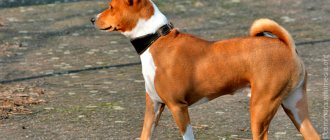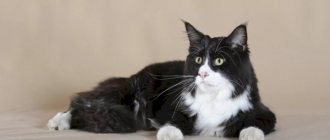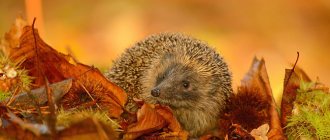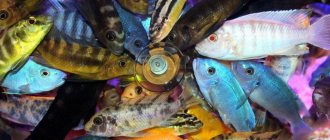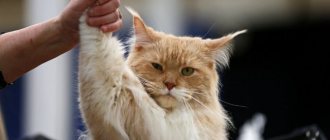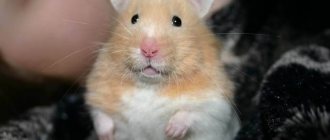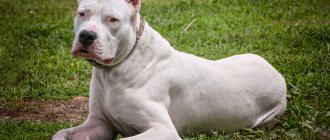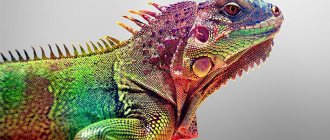- Wild animals
- >>
- Reptiles
Tegu lizards are large reptiles that are commonly kept as pets. There are a number of different species and groups of reptiles called "tegus". The general appearance of domestic tegus are black and white tegus, also called giant tegus, which are native to South America. These lizards are popular pets because they are intelligent and charismatic.
Origin of the species and description
Photo: Daegu
There have been a lot of interesting changes to the tegu, so it's worth taking a look at the different types of these reptiles:
- Argentine black and white tegu (Salvator merianae). This tegu was first introduced to the United States in 1989 when the late, great Bert Langerwerf brought back several species from Argentina that he had successfully bred in captivity. Originally found in Central and South America, specimens have beady skin and black and white patterns throughout their bodies. Their lifespan in captivity appears to be between 15 and 20 years. They grow to approximately 1.5 m in total length and can weigh up to 16 kg. This species includes a type called the Chacoan tegu, which is believed to exhibit more white coloration on the body and face and tend to grow slightly larger. The species also includes the blue form, which has gained popularity in recent years;
- The Argentine red tegu (Salvator rufescens) has very little red coloration, but intensifies as the lizard matures. Males are solid dark red, while females are a more patterned, grayish-red. These tegus also reach a length of up to 1.5 m. They originate from the western part of Argentina, as well as from Paraguay. Paraguayan red tegus display some white patterns mixed with red ones. Males also tend to become stockier than other tegu species, as well as their female counterparts. The Argentine Red Tegu has also gained popularity due to its beautiful coloration, and some are even called "red" because the red color they display is very intense;
- The yellow tegu (Salvator duseni) is native to Brazil and has never been imported to the United States. This is a beautiful species with strong yellow-gold coloring and black on the muzzle and head;
- Colombian black and white tegu (Tupinambis teguixin). This tegu comes from a much warmer climate than the Argentine black and white. Although it has a very similar black and white coloration, it is smaller, growing up to 1.2 m in length, and its skin has a smoother texture than the Argentine species. The most noticeable difference between the two black and white species is the Colombian tegu's one loreal scale compared to two on the entire Argentine tegu (loreal scales are the scales between the nostril and the eye). Many Colombian tegus will not become as tame as Argentine tegus, but this may depend on the owner.
Interesting fact: A recent biological study has shown that the Argentine black and white tegu is one of the very few partially warm-blooded lizards and can have temperatures of up to 10°C.
Distinctive features
The standards that exist today were adopted and approved in 2012. In general, the Dogo Argentino dog breed is an animal that has an athletic appearance and a proportional physique. The skin is elastic, it is very thick, well-developed muscles are visible under it.
In appearance, Argentines look strong and muscular, one might say athletic. These are large animals with large heads. They have a large, strong and robust neck, as well as a powerful jaw. The coat is quite short and only comes in white.
I highlight the following distinctive features of this breed:
- The head is large in size and looks powerful, but is completely proportional to the body. Outlined by smooth lines, without transitions, with no sharp corners. Together with the neck, it forms a powerful muscular arch. The skull is compact, with a slight convexity in front. The bones of the back of the head protrude moderately.
- The nose is black, with wide nostrils. Slightly raised at the tip, has a gradual elevation, smoothly passing to the muzzle.
- The muzzle is elongated, but not flat, and at the same time quite wide. The upper part is concave.
- Lips look short and thick. They have black pigmentation. Mouth with well-developed jaws. The bite is strong, this guarantees the strongest bite and strong grip. A scissor or pincer bite is acceptable. In the cheek area, the muzzle is flat, there are no folds or depressions, the skin is tightly stretched.
- The eyes are almond-shaped and set wide apart. Mid height position. Eye color is dark or hazel. The priority features of the breed include black eyelids, but others are also allowed. The look is lively, alert and a little firm.
- The ears are high and set wide apart. Often cropped, triangular in shape. Uncropped ears are of medium length, wide, thick, with a rounded tip. The coat in the ear area is smooth, shorter than throughout the body. Breed standards allow the presence of small black spots in the ear area, but they should not disturb the harmonious appearance of the animal.
- The body is rectangular, powerful. The withers are well developed and slightly protruding.
- The neck looks powerful, strong, covered with elastic skin. There are small folds on the front that sag a little. The neck area is covered with fur, which is longer than throughout the entire body.
- The chest is wide and deep, forming smooth lines from top to bottom. There is a bend in the area of the ribs, which allows the animal to breathe deeply while running. The stomach is tucked in.
- The back is strong, wide, and has a slight slope in the lumbar region, which also has strong muscles.
- The front legs are straight and level. There are no folds or wrinkles in the elbow area. The shoulders look developed and powerful, quite strong, the pads on the paws are black in color with rough and hard skin.
- The hind legs are located vertically and parallel to each other. The muscles in the hip area are well developed. They are the same as the front ones, only wider and smaller in size. The gait looks confident and graceful.
- The tail is high, fairly thick, and of good length. When the animal is at rest, it hangs down, and during movement it rises slightly, saber-shaped. The coat in the tail area is short and uniform. The length of the coat is no more than 2 cm. Moreover, its characteristics depend on the climate in which the Argentine lives. Accordingly, in hotter conditions the coat is shorter and thinner. In cold climates, the coat is thicker and has a well-developed undercoat.
- Colors. Breed standards allow only one color - white. In this case, the presence of noticeable black spots in the area of the ears and eyes is acceptable. Black marks should make up no more than 10% of the area of the animal's entire head.
Appearance and features
Photo: What a tegu looks like
Tegus are large, strong, intelligent lizards that can grow up to 1.5m in length and weigh over 9kg. The average female is approximately 1 m in length and weighs from 2 to 4 kg. The average male is about 1.3 m long and weighs between 3 and 6 kg. However, there are always exceptions to this rule, including tegus that are smaller and larger than average. Tegus have large, thick heads and “puffy” throats with fatty deposits. Although they usually walk on all fours when threatened, they can also run on their back two legs to appear more intimidating.
Tegus are the only living theids with complete caudal rings alternating with dorsally divided rings and a gap of granular scales separating the femoral from the ventral pores. They lack periorbital scales.
Video: Tegu
Interesting fact: Tegus have round scales, which gives the animal the appearance of being covered in beads.
The tegu can be distinguished from all other theids by the combination of smooth dorsal muscles, a single loreal canal, a cleft of granular scales separating the femoral from the ventral pores, and a cylindrical tail with complete rings alternating with rings divided into the dorsal and lateral sides of the tail.
Tegus have five supraorbitals, the first usually the longest, and the second the largest in area (in some individuals the first and second supraorbitals are almost equal in length). The last supraocular usually contacts the two cilia. The ventral side of the male's head is often uniformly black during breeding. The largest preferred scales are tuberous, hexagonal and longer. The indistinct transverse stripes may be mostly black in adult males or with traces of transverse stripes in females.
Behavior
The lizard leads an active daily lifestyle. She awakens at sunrise, leaves her shelter under stones or tree roots, being active until dusk.
After waking up, she sunbathes for about half an hour to warm up and improve her metabolism.
Adults gravitate toward eating a variety of ripe fruits. Young lizards feed on insects, and as they mature they move on to larger prey, eating amphibians, small reptiles and mammals.
They grab large prey with their teeth and shake it until it dies, and then tear it into pieces convenient for swallowing. Small prey is swallowed whole.
In case of danger, the animal tenses its body and inflates its throat, making characteristic hissing sounds. The final warning is the rhythmic wagging of the tail. If this does not scare away the aggressor, then an instant throw follows, accompanied by a strong bite.
In some regions, tegus hibernate for 2 to 4 months.
Where does the tegu live?
Photo: What a tegu looks like
In the wild, tegus live in a variety of habitats, including tropical forests, savannas, and semi-desert habitats. Unlike some other lizard species, they are not arboreal as adults, but prefer to live on the ground. Like most arboreal reptiles, younger, lighter-colored individuals spend more time in trees, where they feel safe from predators.
In the wild, the Argentine tegu is found in Argentina, Paraguay, Uruguay, Brazil, and now the Miami area in Florida, perhaps in part due to people releasing pets into the wild. Wild Argentine tegus live in pampas grass meadows. Their day consists of waking up, walking to a warming spot, warming up, and then hunting for food. They return to warm themselves up a little more to help them digest their food better, and then they retreat to their burrow and burrow into the ground to cool down and sleep for the night.
The blue Argentine tegu inhabits Brazil, Colombia, La Pampa and French Guiana, and the first six of them arrived in the United States via shipment from Colombia. The breeder noticed the difference in their coloring and skin texture and selectively bred them. Interestingly, today an increasing number of albinos are being produced from the blue species.
Tegus have recently moved into Florida ecosystems, becoming one of the state's most aggressive invasive species. But they may not just become Florida's problem for the long haul. A recent study published in Nature modeled the potential distribution of the species and found that these pangolins could expand their range well beyond state borders. Like many other invasive species, tegus came to the United States as pets. Between 2000 and 2015, as many as 79,000 live tegus may have been imported into the United States—with an unidentified number of breeds in captivity.
Now you know where the tegu is found. Let's see what this lizard eats.
Spreading
Endemic to South America. Distributed throughout Colombia, Venezuela, Guyana to the north of Paraguay, sometimes found in northern Argentina.
Prefers tropical forests, river banks, swamps, dry bushes and plantations of cultivated plants. Hides in armadillo burrows and termite mounds. It also digs its own burrows under tree roots or near large stones. A very timid animal, it usually runs away when in danger, but it can defend itself with strong claws and sharp teeth, and often uses tail strikes. Tegus feed on small mammals, birds, lizards, amphibians, insects, fruits, and often climb into chicken coops. People hunt tegus for their tasty meat, which resembles chicken.
This is an oviparous lizard. Lays 7–36 eggs, which it buries in the ground. The eggs weigh between 17 and 24 grams and are 42 to 54 mm long and 25 to 31 mm wide. Young tegus hatch in 152–171 days.
What does a tegu eat?
Photo: Tegu lizard
Wild tegus are omnivores and will eat anything they can get their hands on: ground-nesting birds and their eggs, nests of small mice, small snakes and lizards, frogs, toads, fruits and vegetables. To properly feed tegus at home, you should offer them a varied diet. For babies, the ratio of protein to fruits/vegetables should be 4:1. For yearlings this may be 3:1, and the ratio for adult tegus may be around 2:1.
Protein sources may include ground turkey, chicken, fresh fish, beef liver, chicken giblets, frozen thawed mice (once a week, depending on size), crickets, mealworms, butterworms, silkworms, tomato worms (dusted) with calcium and eggs (boiled or scrambled). Fruits can include grapes, strawberries, blueberries, melon, blackberries, peaches, nectarines, mangoes, and bananas (sparingly). Vegetables that are good choices include cauliflower, tomatoes, green beans and peas.
Do not feed your tegu onions (or foods prepared with onions), mushrooms or avocado. This can cause serious health risks to other animals, so caution is advised. Given that the tegu will eat all types of food, obesity may occur. Do not overfeed or offer foods that are not suitable for you or your tag. Tegus' diet ratios change slightly as they age, but the basics remain the same.
The amount of food should start with small bite-sized portions and increase as needed. Your tegu will tell you when it is full. If he eats all his food, offer more and be sure to increase the amount you feed your pet regularly. Likewise, if he regularly leaves food out, reduce the amount you offer.
Environmental conditions
When keeping the Argentine tegu, like other reptiles, it is very important to respect environmental conditions
Temperature - you need to provide a temperature gradient so that the pet can regulate its temperature. In the warm part of the vivarium, you need to maintain a temperature of 29.44–32.22 degrees, in the cool part - 24–26.7 degrees. And at the warming up point - 43.33–46 degrees
It is important to understand that these are surface temperatures, not atmospheric temperatures, and you will need an infrared thermometer to check this. At night, you can set the temperature around 24 degrees, but never drop it below 18.33.
It is best to use several heating lamps with low power to create the desired temperature.
Background heating - if the tegu lives in a cool place, it will also need background heating
You can use a ceramic heater for a small vivarium or a tubular heater for a large one. To monitor the temperature, you will also need a thermostat; it is best to take an electronic one.
Lighting – the Argentine tag needs ultraviolet light. To do this, you will need to take the largest tubular ultraviolet lamp that will fit in the vivarium. Or you can take a mercury ultraviolet lamp and place it instead of one of the heating lamps.
Photoperiod - lighting, taking into account heating lamps and ultraviolet radiation, should work in accordance with the daily cycle. Lighting should be present 12-14 hours a day, and there should be no lighting for 10-12 hours. Thanks to this, the tegu will have artificial day and night.
Humidity - since the Argentine reptile loves humid areas in natural conditions, it will need it in the vivarium. A humidity of 60–70% is suitable. If the substrate is chosen correctly and deep, then maintaining moisture will not be difficult. You will need to spray the vivarium with warm water a couple of times a day, and once a week add warm water to the substrate to moisten it.
Water – Tegus should have a large swimming pool, as these lizards love to lie in water. A bowl is also suitable for fry, but for a large lizard you will need a container. For example, a laundry container. Its size should be 35 liters, you need to make sure that the lizard is completely immersed in water. It is also necessary to take into account that tegus can turn the pool over, which means that the vivarium must be well sealed so that water does not leak out.
Features of character and lifestyle
Photo: Argentine tegu
Tegus are solitary creatures that are most active during the day or are completely diurnal. They spend their time alternating between basking in the sun to regulate their body temperature and searching for food. During the winter months, they enter a state similar to hibernation. Destruction occurs when the temperature drops below a certain point. The rest of the year they are quite active creatures. Tegus spend most of their time on the ground and are often found on roadsides or in other disturbed areas. They can swim and can submerge themselves for long periods of time. Tegus are mostly active during the day. They spend the cold months of the year in a hole or under cover.
Argentine black and white tegus often become very docile when they are in a stable environment and require the attention they need. These large lizards actually seem to seek human attention and thrive more when kept in a nurturing environment. Once they learn to trust you, you will have a close friend for many years to come. Although it is a native of South American rainforests and savannahs, the tegu's charismatic nature - and the fact that it can even achieve some level of domestic training - makes it an extremely charming pet and much loved by reptile aficionados.
It's true that these reptiles can be incredibly docile when handled frequently. In fact, they can become very attached to their owners. However, unsocialized or improperly handled animals can become aggressive. Like most animals, your tegu will let you know when it is uncomfortable or worried. The warnings, called precursors to aggression, usually foreshadow a bite or other aggressive behavior. In some cases, the tegu warns that it may bite by stomping its paws, lashing its tail, or loudly panting.
A few final words
Tegu is not for a beginner. You will need a lot of experience in creating the right conditions, feeding and taming other types of lizards, which is not so easy to achieve, but tegus are amazing reptiles to own. Taming and caring for them requires a lot of effort. You need to make sure that you have the time, money and enough space to keep these amazing lizards and care for them the way they require.
If you think you can keep these lizards properly, they can make brilliant pets and you will have a lizard with which you can do everything there is to do with lizards.
Video
Social structure and reproduction
Photo: Mouth of a tegu lizard
The tegu's reproductive season begins immediately after the dormant period. The post-reproductive season is the humid, warm summer months. Reproduction occurs when animals emerge from hibernation in the spring. Three weeks after emergence, males begin to pursue females in the hope of finding a mate, and only about ten days after this do females begin to build nests. The male marks his reproductive base and begins trying to win the female so he can mate. Mating occurs over several weeks, and the female begins building her nest about a week after mating. The nests are quite large, can be 1 m wide and 0.6-1 m high.
The female is very protective of her nest and will attack anything she perceives as a threat. They are known to spew water onto the nest if it becomes dry. The female lays from 10 to 70 eggs in a clutch, but the average is 30 eggs. Incubation time depends on temperature and can last from 40 to 60 days. The Argentine black and white tegu breeds in areas of Miami-Dade and Hillsborough counties. Most of the South Florida population is concentrated in Florida and is spreading to new areas. Miami-Dade County also has a small breeding population of golden tegus. Red tegus have been spotted in Florida, but are not known to breed.
The Argentine black and white tegu is a partially warm-blooded lizard. Unlike birds and mammals, the lizard can only control its temperature during the breeding season from September to December. Biologists believe this ability was adopted as an adaptive trait, allowing the lizard to cope with hormonal changes during the breeding season.
Habitat
First of all, you need to equip a comfortable home for your pet. You will need a strong and durable terrarium, which is quite spacious and designed for the final size of the lizard when it grows up. Tegus climb and jump very well and can overcome barriers 90 centimeters high as adults. Care must be taken to ensure that the lizard cannot get out of the terrarium on its own.
If you purchase a young tegu, you should not equip a vivarium that is not too small. Lizards grow quickly and within two to three months you will have to buy a new one. It is better to first purchase a wooden vivarium measuring 90 by 60 by 60 or 120 by 60 by 60. In such a vivarium, the tegu can live peacefully until it grows to 60 centimeters.
If you are already purchasing a teenage lizard, you can immediately purchase an adult vivarium without spending money on the previous ones. This will be quite comfortable for the lizard, and the owner will not have to change his home several times. For an adult lizard, a vivarium measuring 213 by 90 by 90 or larger is good. And, if there is a pair of tegus, then they will need a house measuring at least 244 by 122 by 122 centimeters.
It is important to note that it is better to choose a wooden or plastic vivarium with a glass front. All-glass vivariums are more likely to stress lizards and are also more difficult to control humidity levels.
It is necessary that the vivarium has a high enough threshold that will allow it to be filled with a layer of substrate. For a fry you will need a layer of about 10 centimeters, for a teenage lizard already 20–25 centimeters, for an adult lizard up to 70 centimeters. This is due to the fact that tegus love to dig. In general, it is immediately clear that tegus require a lot of space, they grow large and will be very uncomfortable in limited conditions.
The substrate can be made from different materials:
- Ecologically clean soil.
- Mixtures of soil and sand.
- Barks for orchids.
- Most people prefer mulch.
In any case, you will need a composition that will retain moisture well and that the lizard can dig.
If you want to decorate a vivarium, it is worth considering that it is better to stick to simple decor. For example, driftwood and rocks are suitable, as is a large shelter for the tegu. But, if the lizard has a fairly deep layer of soil, then it will not need shelter; it will burrow into the substrate. You should not use artificial or live plants, they will be instantly destroyed by the tegu. The drinking bowl and feeder must be strong so that the tegu does not destroy them.
Natural enemies of tegus
Photo: What a tegu looks like
The main predators of tegus are:
- cougars;
- snakes;
- predator birds.
When attacking, the Argentine black and white tegu can shed part of its tail to distract itself from its enemies. By evolution, the tail is very strong, rough and muscular, and can be used as a weapon to strike an aggressor and even inflict a wound. As a defense mechanism, they can run at very high speeds.
Tegus are terrestrial animals (they spend most of their lives on the ground), but they are excellent swimmers. Tegus are important in neotropical ecosystems as predators, scavengers, and seed dispersal agents. They are hunted for their hides and meat by thousands of indigenous and local people and are important sources of protein and income. Tegus make up 1-5% of the biomass collected by local people. However modest the local harvest may be, trade figures show that lizards are being harvested at a tremendous rate. There were 34 million in trade between 1977 and 2006, with cowboy boots being the main end product.
Fun fact: On private lands, Florida hunters without a license are allowed to kill tegu lizards as long as it is done humanely. On public lands, the state tries to get rid of lizards through traps.
Disease: cloaca prolapse
Solution: reconsider the diet - perhaps the food is too fatty. Cloaca prolapse is a common disease that requires urgent treatment to prevent injury and necrosis. Such a disease can occur in case of regular overfeeding of locusts, zoophobos, meat, too frequent feeding of protein, without fasting days and fiber.
Treatment: Make sure the intestine is not damaged. If there are no traces of necrosis, the intestine can be straightened independently. To begin, treat the intestine with Levomekol ointment and carefully move the intestine into place. The main thing here is not to rush and not to damage the intestine during the procedure. Use rubber gloves and sanitary sticks.
Once straightened, cover the cloaca with a band-aid until the next day. Or do not tape it if the lizard does not have new attempts to defecate on the same day. Make sure that the intestine does not prolapse for 3-4 days. Do not feed temporarily, just drink. If the intestine does not fall out after 4-5 days, you can continue to feed. During the treatment period, remove all substrate from the terrarium.
If the intestine has been damaged and there are traces of necrosis, it is necessary to contact a herpetologist to excise the necrotic tissue and fix the intestine in the cloaca with an additional suture.
The same applies if the intestine falls out again. Requires suture fixation.
Further reading[edit]
- Renner, Rebecca (November 18, 2022). "This Dog-Size Lizard Spreads Across the Southeast U.S." National Geographic
. Retrieved November 19, 2022.
| Taxon identifiers | |
| Salvator merianae |
|
| Tupinambis merianae |
|
Reptile selection
It is better to buy tegus from experienced breeders or in special stores. The low price should alert you, because such lizards are sold quite expensively. If an animal is offered cheaply, then most likely it will be old or have health problems. Before you buy the individual you like, you need to:
- learn about the conditions for keeping tegus;
- take an interest in the genetics of your parents.
It would be a good idea to take care of a return guarantee if it suddenly turns out that the animal is suffering from an incurable infection.
If the lizard is overly aggressive during inspection or shows high activity, this may be due to the fact that it experiences stress when strangers appear.
When choosing a pet, you need to carefully examine the lizard you like. It is necessary to check the paws and tail to make sure there are no damages. During a visual inspection, it is important to make sure that there are no abrasions or wounds on the body.
Links[edit]
- ^ ab Scott, N.; Pelegrin, N.; Montero, R.; Kacoliris, F.; Fitzgerald, L.; Carreira, S.; Cacciali, P.; Moravec, J.; Cisneros-Heredia, D.F.; Aparicio, J.; Avila-Pires, T. C. S. (2016). "Salvator merianae" IUCN Red List of Threatened Species
.
2016
: e.T178340A61322552. Retrieved September 4, 2022. - Duméril AM, Bibron G (1839). "Sovegard de Merian, Salvator Meriano, Nobis." Erpétologie générale or Histoire naturelle complete des reptiles
.
5
. Paris: Rore. pp. 85–90. - "Tupinambis merianae". Reptile Database. www.reptile-database.org.
- www.wildherps.com
- Beolen, Beau; Watkins, Michael; Grayson, Michael (2011). " Tupinambis merianae
".
Dictionary of Reptile Eponyms
. Baltimore: Johns Hopkins University Press. paragraph 175. ISBN 978-1-4214-0135-5. - https://www.uco.es/organiza/servicios/publica/az/php/img/web/17_12_32_15NotaRendimientoBasso.pdf page 346
- Jones M, Groening J, Dutel N, Fagan MJ, Evans SE (2017). "Biomechanical role of the chondrocranium and sutures in the lizard skull". Journal of the Royal Society Interface
.
14
(137): 20170637. DOI: 10.1098/rsif.2017.0637. PMC 5746569. PMID 29263126. - Presch W (1974). "Survey of the dentition of macroteid lizards (Teiidae: Lacertilia)". Herpetologica
.
30
(4): 344–349. JSTOR 3891430. - Rieppel, Olivier (1980). "The adductor musculature of the trigeminal jaw of Tupinambis
, with comments on the phylogenetic relationships of Teiidae (Reptilia, Lacertilia)".
Zoological Journal of the Linnean Society
.
69
(1): 1-29. DOI: 10.1111/j.1096-3642.1980.tb01930.x. - Pyron, R.; Burbrink, Frank T.; Vince, John J. (2013). "Phylogeny and revised classification of Squamata, including 4,161 species of lizards and snakes". BMC Evolutionary Biology
.
13
: 93. DOI: 10.1186/1471-2148-13-93. PMC 3682911. PMID 23627680. - ^ ab Blue Tegus (Tupinambis teguixin sp.) at the Wayback Machine (archived December 07, 2002)
- ^ abc Saadoun, A.; Cabrera, M. C. (2008). "Review of the nutritional value and technological parameters of local meat sources in South America." Meat Science
.
Elsevier B.V. 80
(3):570–581. DOI: 10.1016/j.meatsci.2008.03.027. ISSN 0309-1740. PMID 22063568. S2CID 31912208. - ^ abc Saadoun, A.; Cabrera, MS "Table 10 - Uploaded by Maria Cabrera".
- ^a b Maciel, B.M.; Argolu Filho, RC; Nogueira, S.S.C.; Dias, J. C. T.; Resende, R. P. (07 December 2009). "High prevalence of Salmonella in tegu lizards ( Tupinambis merianae
) and serotype sensitivity to antibiotics."
Zoonoses and public health
.
Wiley. 57
(7–8): e26–e32. DOI: 10.1111/j.1863-2378.2009.01283.x. ISSN 1863-1959. - Tattersall GJ, Leite SA, Sanders CE, Cadena V, Andrade D, Abe AS, Milsom WK (2016-01-22). "Seasonal reproductive endothermy in tegu lizards". Advances in Science
.
2
(1): e1500951. Bibcode: 2016SciA…. 2E0951T. DOI: 10.1126/sciadv.1500951. PMC 4737272. PMID 26844295. - Hutchison VH, Vinegar A (1966). "Thermoregulation in a brooding female Indian python, Python molurus bivittatus
."
The science
.
11
(3711): 694–695. Bibcode: 1966Sci…151..694H. DOI: 10.1126/science.151.3711.694. PMID 5908075. S2CID 45839432. - Farmer C. G. (2000). "Parental assistance: a key to understanding endothermy and other convergent functions in birds and mammals." American naturalist
.
155
(3):326–334. DOI: 10.1086/303323. PMID 10718729. S2CID 17932602. - Farmer C. G. (2003). "Reproduction: the adaptive significance of endothermy". American naturalist
.
162
(6):826–840. DOI: 10.1086/380922. PMID 14737720. S2CID 15356891. - Colli GR, Perez AK - Jr., Yes - Cunha HJ (1998). "A new species of Tupinambis
(Squamata: Teiidae) from Central Brazil, with analysis of morphological and genetic variation in the genus."
Herpetologica
.
54
(4):477–492. JSTOR 3893442. - Kiefer, Mara S.; Sazima, Ivan (2002). "Diet of the juvenile tegu lizard Tupinambis meriamae (Teiidae) in Southeast Brazil" (PDF). Amphibian-Reptiles
.
23
(1):93–124. DOI: 10.1163/156853802320877654. - ↑
Hoff, Gerald (6 December 2012). Diseases of amphibians and reptiles. Springer Science & Business Media. P. 643–. ISBN 978-1-4615-9391-1. - "Tegus Directory". Archived from the original on 2009-01-08. Retrieved January 8, 2009.
- ^ abc "Tegu Lizards - CISMA Everglades".
- “Argentine black and white Tegu | FWC".
- “Invasive Tegu Control in Florida | Croc Documents".
- "Tegus - Georgia Invasive Species Task Force".
- “Argentine black and white Tegu | Department of Natural Resources".
- "Invasive tegu lizards make their way across the southeastern US". WBUR-FM
. 2020-12-03. Retrieved December 6, 2022. - "First sighting of black-and-white tegu lizard confirmed in Midlands - South Carolina Department of Natural Resources".
- ^ abc "Invasive tegu lizard spotted in Berkeley County, DNR monitoring".
- Harvey, Michael B.; Hugueto, Gabriel N.; Gutberlet, Ronald L., Jr. (2012). "Review of teiid morphology with revised taxonomy and phylogeny of teiids (Lepidosauria: Squamata)". Zootaxa
.
3459
(1):1–156. DOI: 10.11646/zotaxa.3459.1.1. - Kabanya, Imanol; Chiaraviglio, Margherita; Di Cola, Valeria; Guisan, Antoine; Broennimann, Olivier; Gardenal, Cristina N.; Rivera, Paula S. (2020). "Hybridization and hybrid zone stability between two lizards explained by population genetics and niche quantification". Zoological Journal of the Linnean Society
.
190
(2):757–769. DOI: 10.1093/zolinnean/zlaa018.
